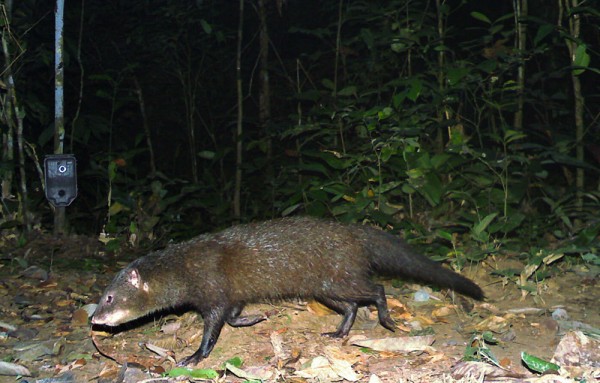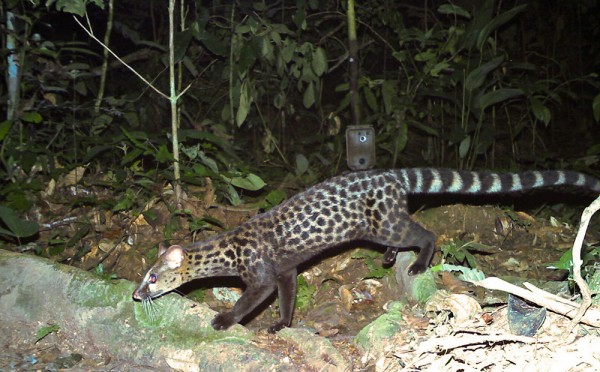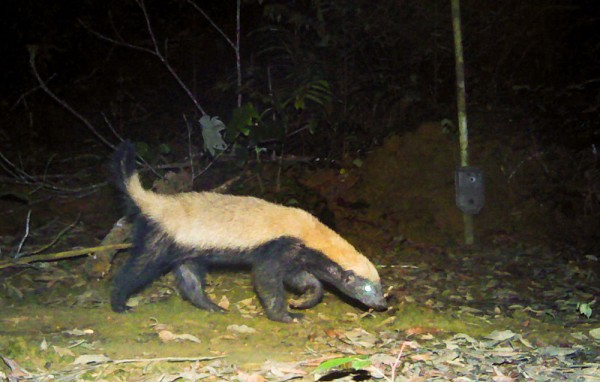Camera Trap Pictures: Rare Badgers, Mongooses Spotted in Gabon
The best things came in small packages for scientists studying Gabon‘s littlest predators.
For the first time, a team surveyed the west African country for its small carnivores, a group traditionally overlooked by scientists. The investigation turned up 12 species, including badgers, mongooses, civets, and genets.
For their study, the researchers compiled data from animal sightings; studies of bush meat, or wildlife killed for food; and remotely triggered camera traps.
A marsh mongoose. Photograph courtesy Laila Bahaa-el-din, Panthera
“A lot of the mammals here are quite curious, and all sorts of species come and put their noses up against the cameras,” study co-author Laila Bahaa-el-Din of Panthera, a big-cat conservation group, said by email.
“A honey badger once turned a camera around, and an African golden cat turned one off.”
Badgers, Mongooses, and More
More than 80 percent of Gabon is covered in dense tropical rain forest, and the bigger animals that live in them—such as the great apes, forest elephants, leopards, and African golden cats—have been well documented. Nearly 10 percent of the country’s land is protected.
So the scientists weren’t surprised to find such a high diversity of small carnivores, noted Philipp Henschel, Panthera’s lion survey coordinator, by email.
A servaline genet. Photograph courtesy Laila Bahaa-el-din, Panthera
The most frequently recorded carnivore was the servaline genet (above), which lives throughout the country. The marsh mongoose is another common, widely distributed species, though it’s unfortunately killed by villagers because of its reputation as a poultry predator, according to Bahaa-el-Din, whose study appeared in the July edition of Small Carnivore Conservation.
The Egyptian mongoose, which lives in open habitat across much of sub-Saharan Africa, was discovered only in the savannah regions in southern Gabon.
An Egyptian mongoose. Photograph courtesy Torsten Bohm
More elusive is the honey badger (below), which seems to inhabit patches of the country and is rarely seen.
A honey badger. Photograph courtesy Laila Bahaa-el-din, Panthera
“Like in other parts of its range, the honey badger has a fearsome reputation among Gabonese communities,” Bahaa-el-Din said, adding that both entirely black and black-and-white badgers have been seen in the country.
Vulnerable Carnivores
The studies also revealed that the carnivores are less abundant and diverse near human settlements—suggesting that if these communities grow, the species could be put under more pressure.
Bahaa-el-Din said that carnivores are “particularly vulnerable” due to multiple threats: the bush meat trade; habitat loss due to deforestation; loss of prey; and hunting, which occurs both to harvest the animals’ body parts for traditional ceremonies and in retaliation for killing livestock.
But knowing the number and location of Gabon’s small carnivores also helps researchers keep track of their populations and develop ways to keep them safe, she said.
What’s more, said Henschel, considering that vast forest regions within Gabon are still unstudied, “it’s likely that the list of small carnivore species confirmed to occur in Gabon will continue to grow.”(Posted by Christine Dell'Amore of National Geographic News in Weird & Wild on October 5, 2013)















